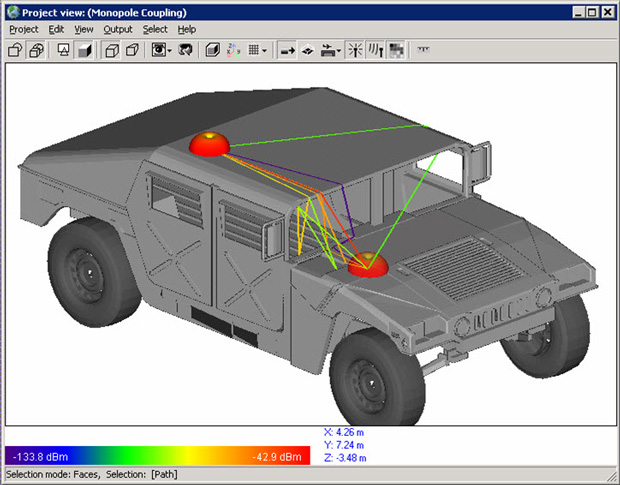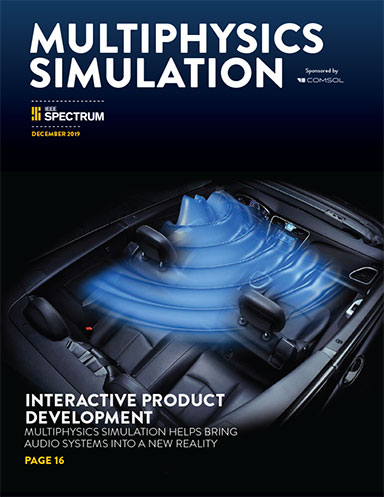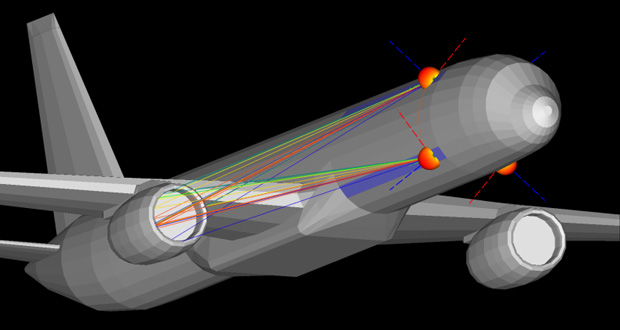Electromagnetic Simulator Updated

XGtd version 2.8 introduces a new Touchstone file export functionality. This co-site analysis image shows transceivers for managing co-located antennas to represent independent, co-located transmitter receiver pairs. S-parameter output can be displayed in a project view and plots or exported as a Touchstone file. Image courtesy of Remcom Inc.
Electromagnetic Simulation News
Electromagnetic Simulation Resources


July 13, 2016
Remcom Inc. has introduced a new version of its XGtd general-purpose, high-frequency ray-based EM (electromagnetic) simulation software. Highlights of the XGtd 2.8 release include several new co-site analysis features, a 64-bit graphical user interface (GUI) and support for KMZ and COLLADA geometry files.
 Version 2.8 of Remcom's XGtd high-frequency ray-based electromagnetic simulation software introduces new co-site analysis features. In this example, co-site interference simulation finds the strongest propagation paths between two patch antennas mounted on the exterior of a Boeing 757 jetliner.
Version 2.8 of Remcom's XGtd high-frequency ray-based electromagnetic simulation software introduces new co-site analysis features. In this example, co-site interference simulation finds the strongest propagation paths between two patch antennas mounted on the exterior of a Boeing 757 jetliner.
Image courtesy of Remcom Inc.
Remcom says XGtd's new co-site analysis features allow users to calculate paths and coupling between transmitters and receivers for electromagnetic interference (EMI) assessment as well as electromagnetic compatibility (EMC) assessment. The addition of transceivers simplifies co-location of functionally independent transmitters and receivers, the company adds. Different transmitter and receiver properties may be assigned to a common transceiver location, including antenna gain pattern, antenna rotation and waveform.
The new release of XGtd also provides S-parameter output for analyzing antenna coupling, which may be plotted like other output or exported to a Touchstone file. The Touchstone export functionality is also new, allowing users to take advantage of this industry-standard format.
Remcom reports that XGtd's new 64-bit GUI improves performance when processing complex, memory-intensive models. Additionally, projects have been made fully portable, enabling users to move or copy an XGtd project between devices. The company further says that the new support for importing and creating KMZ (.kmz) and COLLADA (.dae) geometry files will expedite the import of complex, high-resolution objects to a project.
 XGtd version 2.8 introduces a new Touchstone file export functionality. This co-site analysis image shows transceivers for managing co-located antennas to represent independent, co-located transmitter receiver pairs. S-parameter output can be displayed in a project view and plots or exported as a Touchstone file. Image courtesy of Remcom Inc.
XGtd version 2.8 introduces a new Touchstone file export functionality. This co-site analysis image shows transceivers for managing co-located antennas to represent independent, co-located transmitter receiver pairs. S-parameter output can be displayed in a project view and plots or exported as a Touchstone file. Image courtesy of Remcom Inc.“Users will notice significant changes with this release, including sophisticated upgrades that make the software more intuitive and streamlined,” said Ruth Belmonte, product manager for XGtd, in a press announcement. “The co-site analysis updates are particularly useful when constructing and analyzing an antenna coupling project. And usability updates such as drag-and-drop functionality in the project view and the new 64-bit GUI improve performance and efficiency for users.”
Click here for more details on the enhancements in XGtd version 2.8.
Download the XGtd 2.8 brochure.
See a full list of XGtd's capabilities
Sources: Press materials received from the company and additional information gleaned from the company's website.
Subscribe to our FREE magazine, FREE email newsletters or both!
About the Author
Anthony J. Lockwood is Digital Engineering’s founding editor. He is now retired. Contact him via [email protected].
Follow DE



